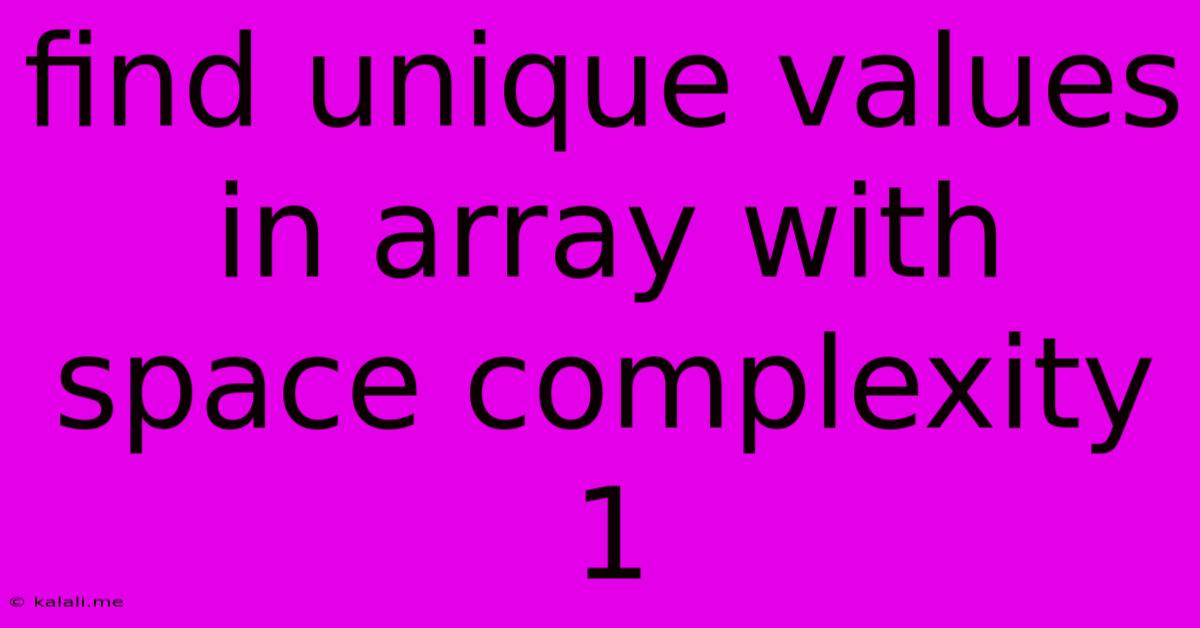Find Unique Values In Array With Space Complexity 1
Kalali
Jun 08, 2025 · 3 min read

Table of Contents
Finding Unique Values in an Array with O(1) Space Complexity
Finding unique values in an array is a common programming task. While many solutions exist, achieving this with O(1) space complexity presents a unique challenge. This means we can't use additional data structures like sets or hash maps that scale with the input size. This article explores how to achieve this, highlighting the limitations and practical considerations.
What does O(1) space complexity mean? It signifies that the memory used by the algorithm remains constant regardless of the input array's size. This is extremely restrictive, and it significantly limits the approaches we can take. We'll need to leverage the array itself to track uniqueness, which will impose constraints on the type of array and the operations allowed.
The Challenges and Limitations
Achieving true O(1) space complexity for finding unique values in a general-purpose array is practically impossible. The fundamental issue lies in needing to track which values have already been encountered. Without extra memory, we're forced to modify the input array itself, which might not always be acceptable.
A Simplified, Yet Impractical Approach (In-Place Sorting)
If we are allowed to modify the input array and the array contains only comparable elements, we could sort it in-place using an algorithm like quicksort or merge sort (which have O(log n) space complexity in the average case, but can be adapted to O(1) in-place variants with sacrifices to time complexity). After sorting, finding unique elements is straightforward: iterate through the array and compare each element to its neighbors. However, even in-place sorting algorithms usually involve a significant amount of swapping and rearranging data, which can render it impractical for large arrays or arrays of complex objects. Furthermore, this approach destroys the original order of the array.
A More Realistic Approach: Restricting the Input
To approach O(1) space complexity more realistically, we must place significant restrictions on the input array. Let's consider a scenario where:
- The array contains only integers within a known, small, and fixed range.
- We are allowed to modify the input array.
In this case, we can use the array's values as indices to mark encountered elements. This requires that the value of each element corresponds to a valid index. Let's illustrate with an example:
Let's say our array is arr = [1, 2, 3, 2, 1, 4] and the range is 1 to 4.
- Initialize a counter variable
countto 0. - Iterate through the array:
- For each element
x, ifarr[x-1] > 0, setarr[x-1] = -arr[x-1]. This marks the element as seen. - If
arr[x-1] <= 0, this means the element has already been seen.
- For each element
- Iterate again, to get the original values
This method uses the array itself to track seen values. The space complexity remains O(1) because the memory usage doesn't scale with the input size. The time complexity, however, becomes O(n), where n is the length of the array, because of the two iterations. But it's crucial to remember the limitations: fixed integer range and the modification of the original array.
Conclusion:
Finding unique values in an array with O(1) space complexity is significantly constrained. While a theoretically possible approach utilizing in-place sorting exists, it sacrifices practicality. A more practical solution involves severely limiting the input array's characteristics, such as restricting the range of values and allowing in-place modifications. For most real-world scenarios, using data structures like sets or hash maps, despite their O(n) space complexity, is more efficient and practical. The O(1) space constraint often necessitates compromising other aspects of the algorithm's performance or applicability.
Latest Posts
Latest Posts
-
Why Does A Rooster Crow All Day
Jun 08, 2025
-
Highlight Cells That Match A List On Different Sheets
Jun 08, 2025
-
How Can You Tell If A Coconut Is Bad
Jun 08, 2025
-
What Happens When You Square Root A Square Root
Jun 08, 2025
-
How To Take Out Permanent Marker From Clothes
Jun 08, 2025
Related Post
Thank you for visiting our website which covers about Find Unique Values In Array With Space Complexity 1 . We hope the information provided has been useful to you. Feel free to contact us if you have any questions or need further assistance. See you next time and don't miss to bookmark.